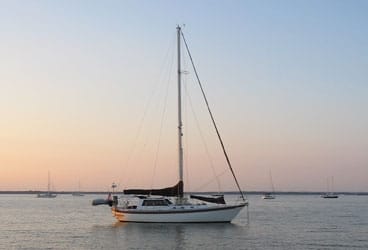
Vancouver 42 368
Robert Harris’ Vancouver designs have earned reputations over the years as reasonably performing, comfortable, and extremely seaworthy cutters for the serious cruiser. One of the most successful of them is the Tayana Vancouver 42.
Beginning in 1979, Ta Yang, one of Taiwan’s top yards, built (some might say overbuilt) about 200 Vancouver 42 hulls in solid fiberglass and polyester laminate, coring the decks with wood-block squares isolated with resin to minimize moisture retention. At hardware-mounting points, this layup was further reinforced. After 1985, the yard used isophthalic gelcoat to resist blistering and, after 1992, laminated the hulls with vinylester resin. The boat’s 11,800 pounds of ballast is in a single iron casting, encapsulated inside the keel’s thick walls.
About 130 of the Van 42s were built as aft-cockpit cruisers with two different house designs. About 70 have center cockpits. One buyer commissioned a pilothouse version from the factory, which subsequently built four more. Our Vancouver 42, Jubilee, is one of them, but the hull and sail plan are the same as on the standard aft-cockpit model. The pilothouse suits us well in our Lake Superior home waters.
While this 29,000-pound canoe-stern cutter with its long fin keel and skeg-hung rudder wouldn’t be a first choice for Wednesday-night racing, the boat’s tall stick, generous sail plan, and slippery underbody ensure respectable passagemaking times. The deep keel and round bilges hold plenty of cruising stores, not to mention 120 gallons of diesel in two black-iron tanks and 150 gallons of water in two stainless-steel tanks.
Van 42s came with a variety of engines; the most common was a 50-horsepower Perkins 4-108. These boats are a bit underpowered, and we repowered with a 75-horsepower turbocharged Yanmar. It moves the boat very well, but we probably would’ve been just as happy with the naturally aspirated 64-horsepower version of that engine.
Most Van 42s were delivered with sturdy double-spreader Isomat spars, which were deck-stepped and heavily stayed. Harris’ unique diamond stay at the upper spreaders, supported by an aluminum arc, which some call the cowcatcher, eliminates the need for running backstays. It also distinguishes the boat in crowded anchorages.
Every Ta Yang boat is semicustom, and owners had much freedom in laying out the accommodations. Even bulkheads were movable. Most interiors were done in vertical spruce staving and teak trim, but several variations exist. Whatever the layout, the stunning quality of Ta Yang’s finish work is a constant.
Most Vancouver 42s were built in the 1980s, so systems may need attention. The black-iron fuel tanks can rust if their external paint is chipped. Happily, we’ve not had this problem with our 18-year-old boat. Hull/deck joints and serious blistering haven’t typically been issues, but some older boats have suffered corrosion on chainplates and their attachment bolts belowdecks.
Most Vancouver 42s were built with teak decks, which can allow water intrusion into the core. However, Ta Yang’s construction techniques have been among the best in the industry. Jubilee’s teak decks have given us no problems, but we did recently reseam them to ensure their integrity.
The Tayana Vancouver 42 is a well-built offshore cruiser with a cruising range, load-carrying capacity, and comfortable motion seldom found in boats under 45 feet today. Age and condition affect asking prices, which range from $80,000 to $180,000.
Bill and Judy Rohde are cruising aboard Jubilee from Lake Superior to the Bahamas.
Vancouver 42
LOA 41′ 9″ (12.72 m.)
LWL 33′ 0″ (10.06 m.)
Beam 12′ 6″ (3.81 m.)
Draft 5′ 10″ (1.78 m.)
Sail Area (100%) 1,009 sq. ft. (93.73 sq. m.)
Ballast 11,800 lb. (5,351 kg.)
Displacement 29,147 lb. (13,219 kg.)
Ballast/D .40
D/L 362
SA/D 17.0
Water 150 gal. (569 l.)
Fuel 120 gal. (455 l.)
Engine Various
Designer Robert Harris








